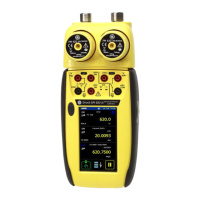Issue 1
10-10 Calibration procedures K0460 - [EN] English
10.10 Procedures
(CH1): Resistance
(measure)
1. Let the equipment get to a stable temperature (minimum: 5
minutes since the last power on).
2. Use the calibration menu (Section 10.3) to do a two-point
calibration for each range.
• Range: 0-400Ω
a. Nominal zero ohms: Make a 4-wire connection to the 0Ω
resistor; see Section 3.2.9 (Example procedure: Measure
or simulate an RTD (or Resistance)), example A.
b. Nominal positive full-scale ohms: Make a 4-wire
connection to the 400Ω resistor; see Section 3.2.9 (A).
• Range: 400Ω-4kΩ.
a. Nominal 400 ohms: Make a 4-wire connection to the
400Ω resistor; see Section 3.2.9 (A).
b. Nominal positive full-scale ohms: Make a 4-wire
connection to the 4kΩ resistor; see Section 3.2.9 (A).
Note: Details of the true ohms option to be issued later.
3. To make sure the calibration is correct, select the applicable
Resistance (measure) function; see Section 3.2.9, (A).
4.
Make a 4-wire connection to the applicable standard resistor
(Table 10-10) and measure the value; see Section 3.2.9, (
A
).
5. Make sure the error is in the specified limits (Table 10-10).
Table 10-10: Resistance (measure) error limits
Standard
Resistor
*
(Ω)
* Or an equivalent resistance simulator
Resistor
uncertainty (Ω)
Permitted
DPI 620-IS error (Ω)
0 (Short circuit) - 0.02
100 0.002 0.032
200 0.004 0.044
300 0.006 0.056
400 0.008 0.068
1k 0.02 0.30
2k 0.04 0.41
4k 0.08 0.64

